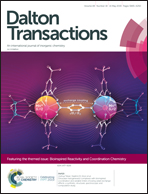Hydrogenase biomimics containing redox-active ligands: Fe2(CO)4(μ-edt)(κ2-bpcd) with electron-acceptor 4,5-bis(diphenylphosphino)-4-cyclopenten-1,3-dione (bpcd) as a potential [Fe4–S4]H surrogate†
Abstract
[FeFe]-hydrogenases contain strongly electronically coupled diiron [2Fe]H and tetrairon [Fe4–S4]H clusters, and thus much recent effort has focused on the chemistry of diiron-dithiolate biomimics with appended redox-active ligands. Here we report on the synthesis and electrocatalytic activity of Fe2(CO)4(μ-edt)(κ2-bpcd) (2) in which the electron-acceptor 4,5-bis(diphenylphosphino)-4-cyclopenten-1,3-dione (bpcd) acts as a surrogate of the [Fe4–S4]H sub-cluster. The complex is prepared in low yield but has been fully characterised, including a crystallographic study which shows that the diphosphine adopts a basal-apical coordination geometry in the solid state. Cyclic voltammetry shows that 2 undergoes four reduction events with DFT studies confirming that the first reduction is localised on the low-lying π* system of the diphosphine ligand. The addition of the second electron furnishes a triplet dianion that exhibits spin density distributed over the diphosphine and diiron subunits. Protonation at the Fe–Fe bond of the triplet dianion furnishes the corresponding bridging hydride as the thermodynamically favoured species that contains a reduced bpcd ligand. Complex 2 functions as a catalyst for proton-reduction at its second reduction potential, in contrast to the related 2,3-bis(diphenylphosphino)maleic anhydride (bma) complex, Fe2(CO)4(μ-pdt)(κ2-bma) (1), which shows similar electrochemical behaviour but is not catalytically active. The difference in chemical behaviour is attributed to greater stability of the 4-cyclopenten-1,3-dione platform in 2 as compared to the maleic anhydride ring of the bma ligand in 1 following the uptake of the second electron. Thus protonation of the Fe–Fe bond in the 22− affords a species which is stable enough to undergo a further reduction–protonation event, unlike the bma ligand whose maleic anhydride ring undergoes deleterious C–O bond scission upon protonation or reaction with adventitious moisture. DFT studies, however, suggest that electron-transfer from the diphosphine to the diiron centre is not significant, probably due to their poor redox levelling. Thus, while the diphosphine is readily reduced, the added electron is apparently not utilised in proton-reduction and hence cannot truly be considered as an [Fe4–S4]H surrogate.
![Graphical abstract: Hydrogenase biomimics containing redox-active ligands: Fe2(CO)4(μ-edt)(κ2-bpcd) with electron-acceptor 4,5-bis(diphenylphosphino)-4-cyclopenten-1,3-dione (bpcd) as a potential [Fe4–S4]H surrogate](/en/Image/Get?imageInfo.ImageType=GA&imageInfo.ImageIdentifier.ManuscriptID=C8DT04906H&imageInfo.ImageIdentifier.Year=2019)
- This article is part of the themed collection: Bioinspired reactivity and coordination chemistry


 Please wait while we load your content...
Please wait while we load your content...